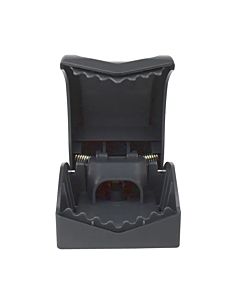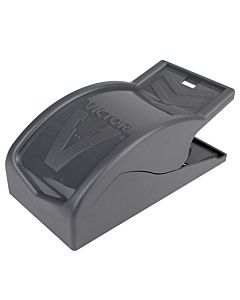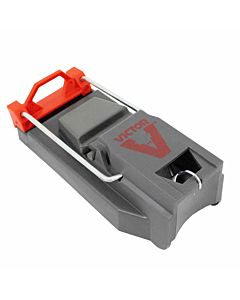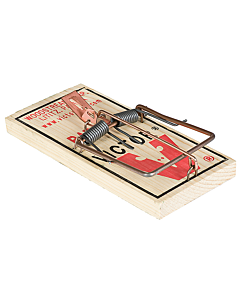How to Get Rid of Voles and Shrews in Your Garden or Lawn

When it comes to rodent control, a lot of coverage has been given to rats and mice, but far less information is available on other little critters. If you've found yourself asking "what is a vole?" or "what is a shrew?", then you've come to the right place.
The following article will examine the two creatures. It will explore vole control products and explain how to get rid of shrews and voles from lawns and gardens.
What is a vole?

A vole is a small, bulky, beady-eyed, mouse-like creature with a long, furry tail and distinct molars. The rodent is alternately known as the field mouse or meadow mouse. When it comes to the question of vole vs mole, the similarities stop with their names.
A small rodent, voles generally grow no more than three inches, though there are some species that reach triple that size. Other features include long whiskers, small ears, tiny feet and a modest tail. Its fur is fine and smooth–usually a brown or gray color.

Roughly 155 vole species exist worldwide. The most widespread North American species is the meadow vole, which inhabits the Great Plains, the Midwest, the Northeast, and most of Canada and Alaska.
Starting along grassland runways, a vole will dig burrows at the base of a plant, devouring roots in the process. A fast-breeding creature, female voles can produce up to 100 young within a year. Weaned from their mothers within a month of birth, voles reach sexual maturity by their eighth week. Male voles are very loyal to their mates and protective of their offspring, while mother voles are typically territorial towards other females.
As a non-hibernating species, voles are active day and night throughout the year. During full moons, however, they lie low because the light can make them visible to predators, such as foxes, snakes and owls. An omnivorous creature, the vole will feast on everything from bulbs, roots and seeds to insects, snails and slugs. The rodent is even known to eat carcasses, bones and antlers. With so many burrows to dig, the vole devours enough food each day to equal its own bodyweight. Due to the creature's fast breeding cycle, vole infestations can spiral out of hand within weeks.
Voles in your lawn or garden
Now that we’ve answered the question “What is a vole,” we need to discuss the damage these little creatures can cause. If you already have voles in your lawn, you probably know they can be a real nuisance.

The main problem with voles is that they're elusive, fast-breeding garden-destroyers. Given the rodent's way with roots, the vole is known to destroy plants and crops. However, most landowners don’t discover infestations until late in the game–well after a whole web of paths and burrows have been dug underground. This is because vole activity generally evades the human eye. Consequently, humans only tend to find out the hard way, such as when a group of valuable plants have suddenly died.
One of the key indicators of voles in a lawn or garden is the poor health of the grass or plants. When a crop of well-watered, healthy plants expires for no apparent reason, voles could be to blame. Bite marks on the plants could make it easier to determine whether a vole or some other critter is the culprit.
As with other rodents, voles carry numerous diseases, including hantavirus, salmonella and babesiosis. Voles also host ticks and other parasites that are transmitters of Lyme disease, ehrlichiosis and Rocky Mountain spotted fever. Due to all the damage and disease associated with the rodent, vole control is a crucial undertaking if an infestation occurs on your property.
Need help with voles and shrews? Try these!
How to get rid of voles
Getting rid of voles can be a difficult task, because their burrows can be hard to spot within a garden or lawn. There are products available to make the chore easier.
Vole poisons, however, are not one of those products. They are notoriously ineffective. Not only do they offer minimal results, only licensed professionals can handle them. While there aren’t any traps specially designed to capture voles, mouse traps can get the job done.
If an infestation has hit your property, and you're really wondering how to get rid of voles, Victor® Mole & Gopher Granular Repellent is highly effective at ridding the critters from their hiding places. This poison-free repellent is safe to use around kids and pets. The granules–when properly distributed–can penetrate burrows and send voles running from your property.
If you're wondering how to kill voles instantly, mouse traps such as the snap traps by Victor® will do the trick. For maximum effectiveness, bait the traps with peanut butter or oatmeal. Then, place them in front of any holes you can spot around your garden. If after five days you don't make any captures, reposition the traps within your yard. When you do catch voles, seal their carcasses–while wearing gloves–into Ziploc bags and throw the bags in a tightly sealed trashcan.
What is a shrew?

A shrew is a small mammal that is often described as looking like a mouse with a longer nose. Its sharp and spiky teeth, however, are far different from the enlarged incisors of rodents.
With 385 species, the shrew is found throughout the world–with the exception of Oceania. Its presence in South America, however, is only due to migration and is limited to the northern half of the Andes. Mole-like in terms of manner and habitat, the shrew discussed here is not to be confused with the otter or elephant shrews of Africa, the tree shrew of Southeast Asia or the extinct West Indies shrew.

A small creature, the typical shrew grows no bigger than the average mouse, though sizes can range depending on the species. The Etruscan shrew, which circles the Mediterranean, swarms Thailand and is also dispersed throughout the Arabian Peninsula, is actually the world's smallest on-land mammal, averaging 3.5 centimeters and two grams. The Asian house shrew, which is native to Southeast Asia and the Indian Subcontinent, has introduced populations in the Philippines and Madagascar. It is the largest of shrew species, growing up to 15 centimeters in length and weighing as much as 100 grams.
A terrestrial animal that haunts trees, burrows and snow, the shrew feeds on everything from nuts and seeds to insects and worms. Though limited in vision, the creature is armed with keen hearing and a sharp sense of smell. Consuming up to 90 percent of its body weight in a given day, the shrew has one of the highest metabolisms of smaller mammals. While the shrew doesn't hibernate, it does go into torpor during winter months. During this time, it sheds up to half its weight and morphs physically, shrinking its bones and internal organs in the process.
The shrew's main disadvantage is its teeth, which wear down over time. This is unlike rodent incisors, which strengthen throughout the span of life.
A territorial creature, the shrew spends most of its time alone. Mating, however, occurs year-round in regions where weather permits–only in colder climates does breeding halt for winter. Females can carry as many as ten litters per year, and gestations last between 17 days and a month. A mother shrew can become pregnant again immediately after giving birth, nursing and carrying at the same time. Most shrews live between one and two and a half years.
There are certain species of shrew that are venomous, which is a rarity among mammals. Used as a defensive weapon against various animal predators, the venom is extracted from the grooves in the shrew's sharp teeth. Highly toxic against mice, a gland-full of venom from the American short-tailed shrew can kill up to 200 of the rodents.
Humans, by contrast, stand to benefit from properties of shrew venom. Certain conditions–including hypertension, migraines and diseases affecting the neuromuscular junction–could possibly be treated by chemicals found within the venom of shrews. Scientists have also studied the benefits of peptide soricidin. Produced in the salivary glands of northern short-tailed shrews, it contains remedial properties in the treatment of ovarian cancer.
Echolocation–a rarity among terrestrial mammals–is characteristic of three species of shrew: the Eurasian shrew that spans England to northern Mongolia, the vagrant shrew local to the Pacific Northwest and the northern short-tailed shrew that's found throughout the U.S. and Canada. Studies into the nature of shrew echolocation show that the creatures use the frequencies to scope out their habitat.
You might be wondering: What is a shrew in terms of its threat to lawn and garden owners?
How to get rid of shrews
At the present time, no fumigants or repellents exist that are known to eradicate shrew infestations. On the upside, shrews are not rodents, so they don't pose the same kinds of problems as rats or mice.
Over the span of 24 hours, a shrew might triple its body weight in bugs, mice, slugs and snails. It’s worth noting the shrew won't intentionally eat away at the roots and bulbs of crucial plants and crops. Even though shrews are known to dig holes here and there, that damage is miniscule to the amount of crop destruction caused by the objects of prey among shrews: rodents and insects.
But in order to avoid the holes shrews can dig, the following steps will make your property less fetching to the mammal's senses. Bear in mind that shrews love water and dark, covered hiding places.
- Place shrew-hospitable shelters away from your garden area.
- Rake up leaves and foliage. Clear away dead branches and garden waste.
- Move all brick and firewood stacks into your garage.
- Mow your lawn on a regular basis (shrews are attracted to tall grass.)
- Clear away overgrown shrubs and low-hanging tree limbs.
- Exterminate insects from your lawn and garden several times each year.
- Try best to prevent puddles from forming on your property. Don't overwater your lawn or garden.
- Cover trash and recycling bins tightly. Keep them inside your garage until pickup day.
- Keep pet bowls inside your house. Don't leave any food outside.
- Clean up bird feeders on a daily basis.
If you have any outdoor pets on your property, feed them once per day and clean up once they've finished. Shrews aren't naturally drawn to birdseed or pet snacks, but they will resort to such food if none of their preferred choices are present. Most importantly, keep excess moisture from depositing around your property. Shrews thrive on water supplies, which also attract the mammal's favorite prey: insects.
If you've followed these steps, and you're still wondering how to get rid of shrews on your property, a cat or dog could be your best weapon. Cats, in particular, are natural predators of shrews. However, cats–like most shrew predators–won't eat the kill because of the foul odor that shrews emit. Another repellant against shrews is the urine of predators, which marks out territory. Well-placed urine spots throughout your lawn could serve as a warning sign that your property is shrew-unfriendly.
If you happen to see a shrew, don't corner or try to grab it. The shrew is a fighting creature, and the least it could do is give you a nasty bite or excrete its foul odor.
Note also that certain species of shrew are protected creatures in certain jurisdictions. Any attempt to trap, kill or transport such creatures could put you on the wrong side of the law. Therefore, contact your local wildlife agency to see how laws apply in your area regarding shrews. If you're given the go-ahead to trap and kill shrews at your own discretion, one of the best ways to accomplish that would be with the use of snap traps by Victor®.





